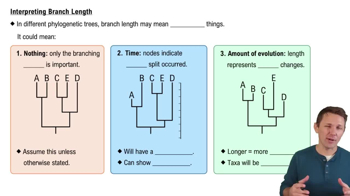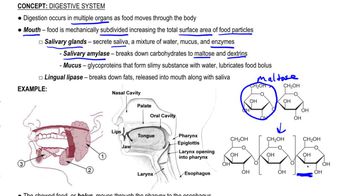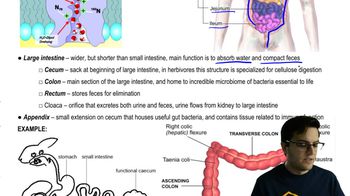Table of contents
- 1. Introduction to Biology2h 42m
- 2. Chemistry3h 40m
- 3. Water1h 26m
- 4. Biomolecules2h 23m
- 5. Cell Components2h 26m
- 6. The Membrane2h 31m
- 7. Energy and Metabolism2h 0m
- 8. Respiration2h 40m
- 9. Photosynthesis2h 49m
- 10. Cell Signaling59m
- 11. Cell Division2h 47m
- 12. Meiosis2h 0m
- 13. Mendelian Genetics4h 44m
- Introduction to Mendel's Experiments7m
- Genotype vs. Phenotype17m
- Punnett Squares13m
- Mendel's Experiments26m
- Mendel's Laws18m
- Monohybrid Crosses19m
- Test Crosses14m
- Dihybrid Crosses20m
- Punnett Square Probability26m
- Incomplete Dominance vs. Codominance20m
- Epistasis7m
- Non-Mendelian Genetics12m
- Pedigrees6m
- Autosomal Inheritance21m
- Sex-Linked Inheritance43m
- X-Inactivation9m
- 14. DNA Synthesis2h 27m
- 15. Gene Expression3h 20m
- 16. Regulation of Expression3h 31m
- Introduction to Regulation of Gene Expression13m
- Prokaryotic Gene Regulation via Operons27m
- The Lac Operon21m
- Glucose's Impact on Lac Operon25m
- The Trp Operon20m
- Review of the Lac Operon & Trp Operon11m
- Introduction to Eukaryotic Gene Regulation9m
- Eukaryotic Chromatin Modifications16m
- Eukaryotic Transcriptional Control22m
- Eukaryotic Post-Transcriptional Regulation28m
- Eukaryotic Post-Translational Regulation13m
- 17. Viruses37m
- 18. Biotechnology2h 58m
- 19. Genomics17m
- 20. Development1h 5m
- 21. Evolution3h 1m
- 22. Evolution of Populations3h 52m
- 23. Speciation1h 37m
- 24. History of Life on Earth2h 6m
- 25. Phylogeny2h 31m
- 26. Prokaryotes4h 59m
- 27. Protists1h 12m
- 28. Plants1h 22m
- 29. Fungi36m
- 30. Overview of Animals34m
- 31. Invertebrates1h 2m
- 32. Vertebrates50m
- 33. Plant Anatomy1h 3m
- 34. Vascular Plant Transport1h 2m
- 35. Soil37m
- 36. Plant Reproduction47m
- 37. Plant Sensation and Response1h 9m
- 38. Animal Form and Function1h 19m
- 39. Digestive System1h 10m
- 40. Circulatory System1h 57m
- 41. Immune System1h 12m
- 42. Osmoregulation and Excretion50m
- 43. Endocrine System1h 4m
- 44. Animal Reproduction1h 2m
- 45. Nervous System1h 55m
- 46. Sensory Systems46m
- 47. Muscle Systems23m
- 48. Ecology3h 11m
- Introduction to Ecology20m
- Biogeography14m
- Earth's Climate Patterns50m
- Introduction to Terrestrial Biomes10m
- Terrestrial Biomes: Near Equator13m
- Terrestrial Biomes: Temperate Regions10m
- Terrestrial Biomes: Northern Regions15m
- Introduction to Aquatic Biomes27m
- Freshwater Aquatic Biomes14m
- Marine Aquatic Biomes13m
- 49. Animal Behavior28m
- 50. Population Ecology3h 41m
- Introduction to Population Ecology28m
- Population Sampling Methods23m
- Life History12m
- Population Demography17m
- Factors Limiting Population Growth14m
- Introduction to Population Growth Models22m
- Linear Population Growth6m
- Exponential Population Growth29m
- Logistic Population Growth32m
- r/K Selection10m
- The Human Population22m
- 51. Community Ecology2h 46m
- Introduction to Community Ecology2m
- Introduction to Community Interactions9m
- Community Interactions: Competition (-/-)38m
- Community Interactions: Exploitation (+/-)23m
- Community Interactions: Mutualism (+/+) & Commensalism (+/0)9m
- Community Structure35m
- Community Dynamics26m
- Geographic Impact on Communities21m
- 52. Ecosystems2h 36m
- 53. Conservation Biology24m
39. Digestive System
Digestion
Problem 16e`
Textbook Question
Minnows are mainly carnivorous, eating insects and other small animals. However, herbivory has evolved independently in minnows several times.
What changes in digestive structure and function are associated with the evolution of herbivory?
Why did the researchers compare relative gut length instead of absolute gut length?
 Verified step by step guidance
Verified step by step guidance1
Understand the dietary shift: Herbivory in minnows involves a shift from a carnivorous diet to one that includes plant material. This shift requires adaptations in the digestive system to efficiently process plant matter, which is typically more fibrous and difficult to digest than animal matter.
Identify structural changes: Herbivorous minnows may develop longer intestines or specialized gut structures such as ceca or fermentation chambers. These adaptations help break down cellulose and other complex carbohydrates found in plants, often with the aid of symbiotic microorganisms.
Examine functional changes: The digestive enzymes in herbivorous minnows may differ from those in carnivorous minnows. Enzymes like cellulase, which breaks down cellulose, might be more prevalent or active in herbivorous species.
Consider the importance of relative gut length: Researchers compare relative gut length (gut length relative to body length) rather than absolute gut length to account for differences in body size among individuals or species. This allows for a more accurate comparison of gut adaptations related to diet.
Explore evolutionary implications: The evolution of herbivory in minnows suggests selective pressures that favor individuals with digestive systems capable of processing plant material. This can lead to increased survival and reproduction in environments where plant resources are abundant.
 Verified video answer for a similar problem:
Verified video answer for a similar problem:This video solution was recommended by our tutors as helpful for the problem above
Video duration:
1mPlay a video:
Was this helpful?
Key Concepts
Here are the essential concepts you must grasp in order to answer the question correctly.
Evolution of Herbivory
Herbivory in minnows involves adaptations that allow them to digest plant material efficiently. This evolutionary change often requires modifications in digestive enzymes and gut morphology to break down cellulose and other plant components. Understanding these adaptations helps explain how minnows can shift from a carnivorous diet to herbivory.
Recommended video:
Guided course

2) Exploitation (+/-): Herbivory
Digestive Structure and Function
Digestive structure and function refer to the physical and biochemical systems that enable organisms to process food. In herbivorous minnows, changes may include elongated intestines for increased digestion time and specialized enzymes for breaking down plant matter. These adaptations are crucial for extracting nutrients from a plant-based diet.
Recommended video:
Guided course

Digestion and Digestive Tracts
Relative Gut Length
Relative gut length is the ratio of gut length to body length, providing a standardized measure across different sizes of fish. Researchers use this metric to compare digestive efficiency and adaptation to diet, as it accounts for size variations that absolute gut length does not. This approach helps in understanding evolutionary changes in gut morphology related to diet.
Recommended video:

Interpreting Branch Length
Related Videos
Related Practice















![Anatomy and Physiology of the Large Intestine [Colon]](https://img.youtube.com/vi/F4W2DLIKXww/mqdefault.jpg)




![IGCSE BIOLOGY REVISION - [Syllabus 7.5] Absorption](https://img.youtube.com/vi/TEOB94oBZN4/mqdefault.jpg)


























